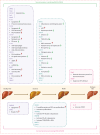Secreted proteins in treating metabolic dysfunction-associated steatotic liver disease: from bench towards bedside
- PMID: 40243151
- PMCID: PMC12342155
- DOI: 10.1093/procel/pwaf027
Secreted proteins in treating metabolic dysfunction-associated steatotic liver disease: from bench towards bedside
Abstract
Metabolic dysfunction-associated steatotic liver disease (MASLD) has become a global epidemic, yet effective pharmacological treatments remain limited. Secreted proteins play diverse roles in regulating glucose and lipid metabolism, and their dysregulation is implicated in the development of various metabolic diseases, including MASLD. Therefore, targeting secreted proteins and modulating associated signaling pathways represents a promising therapeutic strategy for MASLD. In this review, we summarize recent findings on the roles of emerging families of secreted proteins in MASLD and related metabolic disorders. These include the orosomucoid (ORM) family, secreted acidic cysteine rich glycoprotein (SPARC) family, neuregulin (Nrg) family, growth differentiation factor (GDF) family, interleukin (IL) family, fibroblast growth factor (FGF) family, bone morphogenic protein (BMP) family, as well as isthmin-1 (Ism1) and mesencephalic astrocyte-derived neurotrophic factor (MANF). The review highlights their impact on glucose and lipid metabolism and discusses the clinical potential of targeting these secreted proteins as a therapeutic approach for MASLD.
Keywords: clinical application; hepatic lipid metabolism; metabolic dysfunction-associated steatohepatitis; metabolic dysfunction-associated steatotic liver disease; secreted proteins.
© The Author(s) 2025. Published by Oxford University Press on behalf of Higher Education Press.
Conflict of interest statement
The authors declare no conflicts of interest.
Figures


Similar articles
-
Metabolic Dysfunction-Associated Steatotic Liver Disease (MΑSLD).2025 Aug 9. In: StatPearls [Internet]. Treasure Island (FL): StatPearls Publishing; 2025 Jan–. 2025 Aug 9. In: StatPearls [Internet]. Treasure Island (FL): StatPearls Publishing; 2025 Jan–. PMID: 31082077 Free Books & Documents.
-
Genetic depletion of adipose-derived Isthmin-1 causes hepatic steatosis.Mol Metab. 2025 Aug;98:102172. doi: 10.1016/j.molmet.2025.102172. Epub 2025 May 26. Mol Metab. 2025. PMID: 40436204 Free PMC article.
-
Food Nutrients and Bioactive Compounds for Managing Metabolic Dysfunction-Associated Steatotic Liver Disease: A Comprehensive Review.Nutrients. 2025 Jul 3;17(13):2211. doi: 10.3390/nu17132211. Nutrients. 2025. PMID: 40647314 Free PMC article. Review.
-
Metabolic-dysfunction associated steatotic liver disease and atrial fibrillation: A review of pathogenesis.World J Cardiol. 2025 Jun 26;17(6):106147. doi: 10.4330/wjc.v17.i6.106147. World J Cardiol. 2025. PMID: 40575425 Free PMC article. Review.
-
Metabolic dysfunction-associated steatotic liver disease: A story of muscle and mass.World J Gastroenterol. 2025 May 28;31(20):105346. doi: 10.3748/wjg.v31.i20.105346. World J Gastroenterol. 2025. PMID: 40495947 Free PMC article.
References
-
- Abdelmalek MF, Sanyal AJ, Nakajima A. et al. Pegbelfermin in patients with nonalcoholic steatohepatitis and compensated cirrhosis (FALCON 2): a randomized phase 2b study. Clin Gastroenterol Hepatol 2024;22:113–123.e9. - PubMed
-
- Ahuja P, Bi X, Ng CF. et al. Src homology 3 domain binding kinase 1 protects against hepatic steatosis and insulin resistance through the Nur77-FGF21 pathway. Hepatology 2023;77:213–229. - PubMed
Grants and funding
LinkOut - more resources
Full Text Sources
Miscellaneous

